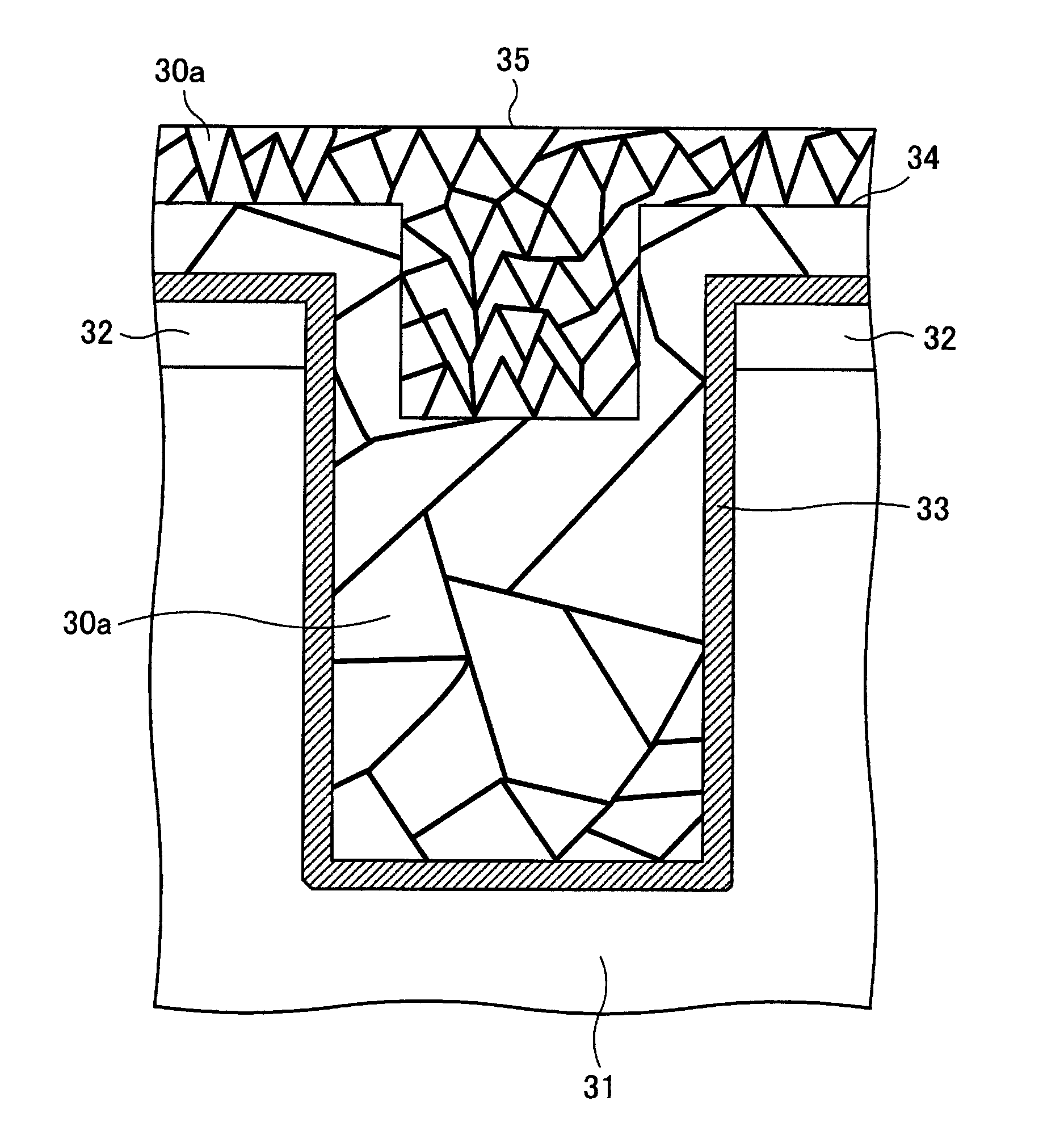Semiconductor device and method for fabricating the same
a semiconductor and semiconductor technology, applied in the field of semiconductor devices, can solve the problems of poor adhesion at the interface between the cap film and the copper wiring, increase the resistance of the wiring, and deterioration of the reliability of the circuit by electromigration, so as to achieve stable fabrication of the semiconductor and highly reliable metal wiring
- Summary
- Abstract
- Description
- Claims
- Application Information
AI Technical Summary
Benefits of technology
Problems solved by technology
Method used
Image
Examples
example 1
[0086]An example using the method in which the condition of electric current density is controlled at electroplating time will be described. FIGS. 10A through 10J are sectional views showing steps for forming a copper wiring. A transistor portion is not shown. The steps will be described in order.
[0087]FIG. 10A is a fragmentary schematic sectional view showing the step of forming an interlayer dielectric and a hard mask.
[0088]A low dielectric constant (low-k) film of silicon oxide carbide (SiOC) with a thickness of about 250 nm is deposited first over a foundation insulating film 51 of SiO2 formed over a silicon substrate 50 by the CVD method to form an interlayer dielectric 52. A hard mask 53 with a thickness of about 50 nm is formed over the interlayer dielectric 52.
[0089]FIG. 10B is a fragmentary schematic sectional view showing the step of forming a groove.
[0090]After the interlayer dielectric 52 and the hard mask 53 are formed, a groove 54 with a width of 100 to 1000 nm for a l...
example 2
[0115]An example using the method in which ion implantation is used will be described.
[0116]The same steps that are shown in FIGS. 10A through 10C of the above example 1 are performed for forming a copper wiring. In a next electroplating step of FIG. 10D for forming a lower layer copper wiring, the conventional method is used for forming a copper film 56. That is to say, electric current density is set to about 3 mA / cm2 in the beginning stage of the electroplating in which a lower portion and lower sidewall portions of a groove 54 shown in FIG. 10C are filled in, and is then increased gradually. The electric current density is set to 20 mA / cm2 in the middle stage of the electroplating in which a central portion of the groove 54 is filled in. After that, the electric current density is not changed until the groove 54 is completely filled in.
[0117]Planarization is then performed by the CMP in the same way that is shown in FIG. 10. After that, ion implantation is performed before a cap...
example 3
[0125]An example using the method in which the electroplating step is divided into two parts will be described.
[0126]The same steps that are shown in FIGS. 10A through 10C of the above example 1 are performed for forming a copper wiring. In a next electroplating step of FIG. 10D for forming a lower layer copper wiring, electroplating is performed twice under different conditions.
[0127]First, electric current density is set to about 3 mA / cm2 in the beginning stage of first electroplating. The electric current density is gradually increased and is set to 20 mA / cm2 in the middle stage of the first electroplating. By doing so, a lower portion, lower sidewall portions, and a central portion of a groove 54 shown in FIG. 10C are filled in. The first electroplating is ended at this point of time. In this state heat treatment is performed at a temperature of about 350° C. As a result, copper grains grow and their grain sizes increase. After the heat treatment is performed, second electroplat...
PUM
| Property | Measurement | Unit |
|---|---|---|
| width | aaaaa | aaaaa |
| width | aaaaa | aaaaa |
| width | aaaaa | aaaaa |
Abstract
Description
Claims
Application Information
 Login to View More
Login to View More - R&D
- Intellectual Property
- Life Sciences
- Materials
- Tech Scout
- Unparalleled Data Quality
- Higher Quality Content
- 60% Fewer Hallucinations
Browse by: Latest US Patents, China's latest patents, Technical Efficacy Thesaurus, Application Domain, Technology Topic, Popular Technical Reports.
© 2025 PatSnap. All rights reserved.Legal|Privacy policy|Modern Slavery Act Transparency Statement|Sitemap|About US| Contact US: help@patsnap.com



